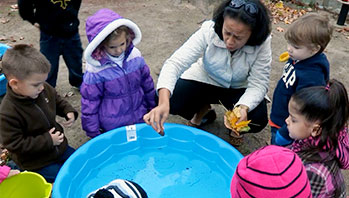- chart paper
- clipboard
- grown sprouts
- magnifying lenses
- paper bag (one for each pair)
- pen
- sprout plants
- cultivate
- environment
- leaf
- plant
- root
- seed
- stem
MA Standards:
Language/L.PK.MA.6: Use words and phrases acquired through conversations, listening to books read aloud, activities, and play.
Head Start Outcomes:
Logic and Reasoning/Reasoning and Problem Solving: Classifies, compares, and contrasts objects, events, and experiences.
Science Knowledge/Scientific Skills and Method: Observes and discusses common properties, differences, and comparisons among objects.
Science Knowledge/Scientific Skills and Method: Collects, describes, and records information through discussions, drawings, maps, and charts.
PreK Learning Guidelines:
English Language Arts/Language 2: Participate actively in discussions, listen to the ideas of others, and ask and answer relevant questions.
Science and Technology/Inquiry Skills 4: Record observations and share ideas through simple forms of representation such as drawings.
Explore Together (outdoors): Plants on the Ground #2

© Commonwealth of Massachusetts, Department of Early Education and Care. All rights reserved.
STEM Key Concepts: Plants grow in many places; There are many different types of plants; Many foods that animals, including humans, eat come from plants; We eat certain leaves, roots, fruits, and seeds; Respect the environment and do not harm plants and other living things
ELA Focus Skills: Listening and Speaking, Vocabulary
Educator Tip: Before the activity, search out a safe area with plenty of plant life. If you are close to a community garden or you have a private garden that might be a good place to explore.
Safety Tips:
- Be aware of and check areas for poison ivy, poison sumac, nettles, and bushes with thorns before taking children outside.
- Remind children to wash their hands before and after the activity.
- Remind children not to eat ANY plants or touch any plants without asking an adult.
- Children’s allergies need to be taken into account before going outside.
Before the activity, have assigned children rinse the sprout plants and record the task on the chart. Then have children look at the sprout seeds.
- Distribute sprouts to children. Tell children you want them to examine the sprouts with a magnifying lens to see how they’ve changed. Have children identify and describe the parts of the sprouts they can see (seed, stem, leaves, roots).
- Take children outside to explore and make connections to the sprout plants and other plants in their natural environment.
Take children outside and have them work in pairs. Encourage them to use their magnifying lenses to look closely at the plants they see. Direct them to compare plants they see in the outdoor environment to the sprouts they are growing inside.
Circulate and listen to children’s observations. Engage them if you notice they are interested in something or if they have questions. Ask questions such as,
- How is this plant similar to the sprouts you examined inside? What is different about it?
- How are these seeds similar to the sprout seeds you are growing? How are they different?
- What do you notice about the number of the leaves on these plants compared to the number of the leaves on the sprouts?
Before taking children inside, allow time for them to collect any plant parts that they observed on the ground. Remind children not to pull any plants or plant parts, but only to pick up parts that have already fallen from the plant onto the ground.
Reflect and Share
Once inside have pairs share observations they made while examining plants. Encourage children to use the sprout seeds and the grown sprouts to help them describe their findings. Ask children to draw in their science notebooks to record a plant or plant part that was similar to or different from their sprout seeds.
Educator Tip: If you see any evidence of animals having eaten any of the plants, prompt children to explore that area and, if necessary, prompt them to recognize the evidence with questions such as,
- How is this acorn different from the one under the tree? Why do you think that is?
- What do you notice is on that plant? Why do you think part of the leaf is gone?
